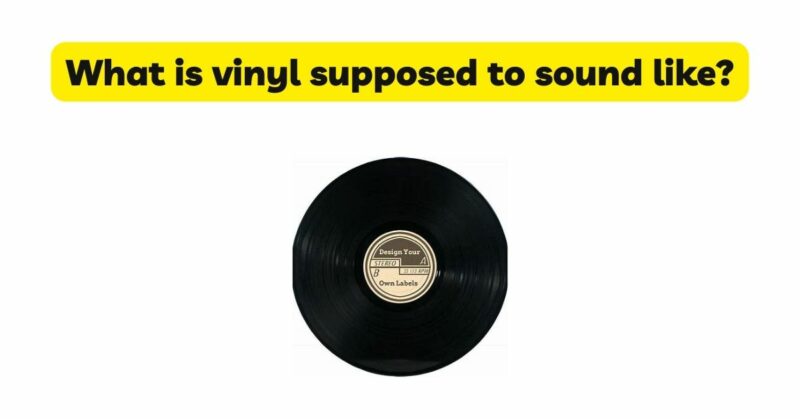Vinyl records have a timeless allure, captivating music enthusiasts with their distinct sound and tangible experience. However, understanding what vinyl is supposed to sound like requires a nuanced exploration of its unique characteristics, artistic intent, and the subjective perceptions of listeners. In this article, we will embark on a journey to unravel the essence of vinyl sound reproduction and shed light on the expectations associated with this beloved medium.
- The Analog Warmth and Character: Vinyl sound is often associated with its inherent warmth, depth, and tonal richness. The analog nature of vinyl reproduction imparts a unique character to the sound, distinct from the precision and accuracy of digital formats. The subtle imperfections and nuances of vinyl playback contribute to its organic and engaging sonic tapestry.
- Embracing the Vinyl Aesthetic: Vinyl enthusiasts appreciate the format not only for its sound but also for the aesthetic and emotional connections it evokes. Vinyl is supposed to sound like a portal to a bygone era, capturing the essence of the time when it reigned as the primary medium for music reproduction. The vinyl aesthetic represents nostalgia, authenticity, and a tangible link to music history.
- Soundstage and Spatial Presentation: Vinyl sound reproduction often provides a sense of a wider soundstage and spatial presentation compared to digital formats. The analog nature of vinyl allows for a greater depth and immersion, creating a captivating three-dimensional sonic experience. Vinyl is celebrated for its ability to transport listeners into the recorded environment, capturing the ambiance and spatial cues.
- Dynamic Range and Musical Fidelity: Vinyl records have the potential to deliver an impressive dynamic range, capturing the full spectrum of musical expression. The format allows for faithful reproduction of delicate nuances and the power of crescendos, providing a sense of realism and emotional impact. Vinyl is expected to sound like a faithful representation of the original musical performance, preserving the dynamic contrast.
- Balance between Clarity and Warmth: Vinyl sound is often characterized by a delicate balance between clarity and warmth. While digital formats can offer pristine clarity, vinyl adds a certain warmth, smoothness, and tonal richness that many find appealing. The format is supposed to sound like a fusion of technical accuracy and organic qualities, providing an engaging and emotionally satisfying listening experience.
- Surface Noise and Imperfections: Vinyl sound is not exempt from imperfections and surface noise. Pops, crackles, and background hiss can be present due to factors like wear, dust, or imperfections on the record surface. While some listeners may find these imperfections charming and authentic, others may prefer a cleaner and quieter listening experience. The presence of surface noise is a characteristic element of vinyl sound.
- Artistic Intent and Vintage Production Techniques: Vinyl records have a rich history as an artistic medium, with production techniques tailored to the format’s unique characteristics. Artists and producers have historically taken into account the limitations and sonic qualities of vinyl during the mastering and production processes. Vinyl is supposed to sound like an authentic representation of the artist’s intent, capturing the nuances and atmosphere of the original recording.
- Listener Expectations and Subjectivity: Listener expectations play a significant role in defining what vinyl is supposed to sound like. Individual preferences, cultural influences, and personal listening experiences shape these expectations. Some listeners may prioritize technical accuracy and transparency, seeking a faithful reproduction of the recorded material, while others appreciate the organic qualities and nostalgic charm associated with vinyl sound.
- The Vinyl Experience and Engagement: Vinyl sound is not solely about sonic perfection but also about the overall experience it offers. Engaging with vinyl involves the tactile interaction of handling the record, carefully placing it on the turntable, and manually lowering the needle. The rituals and engagement required for vinyl playback contribute to the immersive and emotionally fulfilling experience that vinyl is supposed to deliver.
- Embracing the Multifaceted Vinyl Sound: Defining what vinyl is supposed to sound like is a multi-dimensional exploration that encompasses technical accuracy, artistic intent, listener expectations, and the inherent qualities of the format. Embracing the diverse elements that contribute to vinyl sound allows for a deeper connection to the music and a greater appreciation for the unique experience that vinyl records provide.
Conclusion: What vinyl is supposed to sound like is a subjective and multifaceted concept influenced by various factors. Vinyl sound is characterized by its analog warmth, tonal richness, and ability to evoke nostalgia. It offers a captivating sonic tapestry with a wide soundstage, immersive spatial presentation, and an engaging balance between clarity and warmth. Vinyl sound is also shaped by surface noise and imperfections, which are celebrated by some as authentic elements of the format. Ultimately, the essence of vinyl sound lies in its ability to transport listeners to a bygone era, evoking emotions and connections that extend beyond technical perfection.


